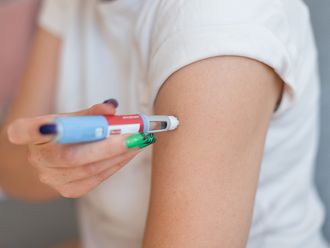
"Have you got a fish tank?” asked the doctor. That seemed a strange question when I’d gone to see him about watery and painful recurring blisters on my right thumb and palm. Anyway, I admitted I did have tropical fish and he concluded it was a disease related to that and prescribed antibiotics. But the tablets didn’t improve matters.
Three months later the skin problem had spread; first covering the palm of my right hand, then my left hand, the sole of my right foot, then my left foot. A dermatologist diagnosed it as pustular psoriasis (a rare form of psoriasis) triggered by the immune system mistakenly attacking the skin.
The blisters weren’t producing pus but exuding white blood cells, and he said that while treatments could ease the condition, psoriasis was incurable. Incurable? I found that hard to accept as medical science has cracked much bigger problems. Plus I’d always had beautiful skin, so what had changed? Still, he was the expert, so I accepted the treatments he recommended.
I was 48, a mature undergraduate psychology student at Staffordshire University and was struggling to take notes in seminars as the painful skin made it hard to hold a pen, let alone write. In shops as I held out my hand to take my change I felt embarrassed noticing people looking and wincing, so I started wearing white cotton gloves. In summer my sore feet made it difficult to wear sandals, or even walk at times. In winter I applied foot cream then cling film so the cream would stay put, then put on two pairs of socks for cushioning.
For two years I tried all the treatments the consultant prescribed. Steroids stripped the skin off my palms leaving them even more red raw. Prescribed creams made the skin more painful. Sun lamp treatment didn’t help me either. The doctor suggested putting me on a trial for a new drug, but when he mentioned it could cause liver damage I said, ‘no thanks’. I asked whether diet could make any difference, but he dismissed the notion.
I was grateful that at least my condition wasn’t on my arms, legs or head and would sit in the hospital clinic feeling sorry for others whose bodies were covered in psoriasis plaques. However, some days I couldn’t walk, others I couldn’t do anything with my hands. Life became about doing what I could when I could rather than doing something from choice. Frustrated with unsuccessful prescribed treatments I decided to do some internet digging about psoriasis.
I found Chinese research papers that suggested changing the environment in the gut to improve the immune system so it wouldn’t destroy the skin. It became clear that I needed to work on my insides so I started emailing Chinese specialists for advice – and got responses! Their immediate reaction was always along the lines of, “What do you mean you’ve been told your condition is incurable? It’s perfectly curable.” The Chinese suggested flooding the intestines with probiotics (friendly bacteria) to re-establish a healthy gut flora. I couldn’t get an import licence for their probiotics, so I decided on a different approach – to look for what was making my gut unhealthy. I opted to cut out sugar – dextrose, maltose, sucrose – and initially my skin started improving. I began eating more fruit, at least five portions daily, and my skin got much worse. I couldn’t understand why.
Then I had a light-bulb moment. I was leaning too heavily on fructose – fruit sugar – so I cut that out too. The psoriasis vanished within two weeks. I’d always had a very sweet tooth, had enjoyed a large slab of milky chocolate every day, but I began to realise that sugar was my addiction and messed up my system. It all had to go.
I had been in so much pain and distress that I was prepared to try anything, including such a difficult dietary restriction – and it worked!
I still wanted to take probiotics to maximise gut health and found a yogurt drink called Bio-Kult that has 14 different bacteria strains, whereas many only have one or two, plus are often laden with sugar. Having lived in the Middle East for five years I also knew that many people drink laban to support the gut, so I do that too, plus I take milk thistle to support my liver and help it clear toxins, along with the whole range of B vitamins.
It’s been seven years now that I’ve controlled my skin, but if I slip and have a bit of sugar I’m in trouble. Twice recently I’ve made that mistake. While in Greece I couldn’t resist their delicious tomatoes – but tomatoes are fruit. Within two days psoriasis broke out under my right foot and on my palms. Then, a few weeks ago, it was my daughter Jessica’s 21st birthday, and she had a big cake. Badgered by people to have a slice I succumbed, had a tiny piece and, again, within two days my palms were covered in watery blisters. Thankfully I now know how to swiftly return my skin to healthy again.
PSORIASIS – THE FACTS
What is it?
This skin condition occurs when skin-cell production speeds up so that instead of being replaced every three to four months the process lasts only three to seven days. There are several different types of psoriasis, the most common being plaque psoriasis, which features dry, red patches covered in silvery scales. Pustular psoriasis – where watery blisters appear before peeling off – can affect different parts of the body, although the particular type known as palmoplantar pustular psoriasis is confined to the palms and soles and pustules may reappear every few days.
What causes it?
While not fully understood, it’s believed psoriasis is caused by a problem with the immune system. There can also be a genetic link. The problem mostly begins in adults aged under 35 and may be triggered by a skin injury, throat infections, smoking, stress, or certain medicines. It is not contagious.
What are the usual treatments?
Topical treatments (creams and ointments) are tried first – often corticosteroids. Phototherapy (exposure to ultraviolet light) may help some. For severe cases oral or injected medication may be advised.
AN EXPERT VIEW
Dr Roula Amer, a dermatologist at the American Hospital of Dubai, says, “Although there are many reports about people who believe diet affects their psoriasis, to date there is no study proving a link. This does not mean that there might not be one.
“Some clinics recommend an omega-3 diet for psoriasis – mainly fish and vegetarian. Others recommend limiting animal foods such as sausage, cream, butter and eggs, as they contain arachidonic acid, and are considered ‘acid bombs’ that promote inflammation. Some suggest psoriasis patients avoid foods that increase uric acid and blood lipids (such as offal, asparagus and fatty foods) and foods with an effect on the nervous and vascular system (such as coffee, preservatives, dyes, pepper, paprika, curry and chilli).
“Some doctors do see the liver’s role as highly important. If the natural intestinal flora are strongly colonised by yeast, for instance, it can lead to a build-up of toxins that keep the liver unnecessarily busy. If that happens the immune system will eventually get exhausted and not know anymore what it should defend first.
“However, there are no studies showing that intestinal colonisation with yeast can lead to a worsening of psoriasis or that reorganisation of the intestine (through foods or supplements) improves psoriasis. That does not mean such a correlation can be ruled out.
“In general it’s recommended that psoriasis patients should maintain a healthy weight and follow a healthy balanced diet – especially if in addition to psoriasis the patient also suffers from other conditions such as obesity, diabetes, gout, liver disease, biliary disorders or digestive disorders. Patients should also monitor their psoriasis and if their skin worsens after eating certain foods they can try to stop eating them and observe what happens. Extreme diets should be avoided though as they are sometimes time-consuming, difficult to stick to and, in some cases, even harmful.”












